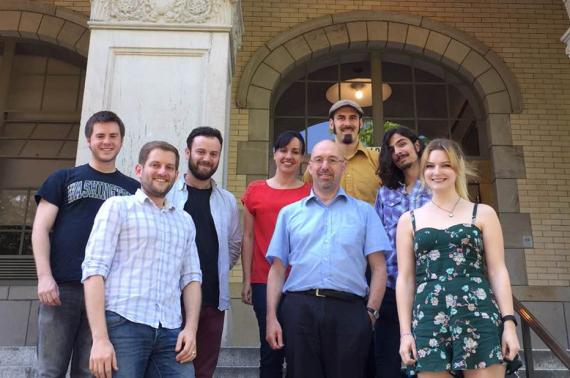Professor Walter Erhart was the Spring 2015 Distinguished Max Kade Visiting Professor in the Department of Germanics. While in the department, he offered a seminar on German literature entitled: Around the World. Travel Literature and Global Experience (1770-1860).
Interview with Professor Walter Erhart, Universität Bielefeld
Distinguished Max Kade Visiting Professor
By Justin Mohler and Jonathan Epstein
Spring 2015
JM: What were your research interests before coming to the University of Washington as a Max Kade Visting Professor, and then maybe you could comment on the seminar this quarter?
WE: Initially I worked on gender and masculine studies; specifically narratives of masculinity in the 19th and 20th centuries, and recently completed a book on Wolfgang Koeppen and the aesthetics of failure in 20th century literature.
JM: How did you get interested in travel literature?
WE: (slight chuckle) That was actually almost by chance, although I had studied travel literature, mostly of the German tradition. I had read well-known traditional travelogues, for example travel literature by German authors traveling either through Germany or to Italy, like Goethe’s Italienische Reise or Fontane’s Wanderungen durch die Mark Brandenburg. But then I stumbled upon Adelbert von Chamisso. However, at first I wasn’t interested so much in his travel literature (his report on a journey round the world), but rather in his split personality as a natural scientist and a poet. (As an aside)—this dualism of course has a lot to do with the history of the humanities and literary criticism which I am very much interested in. Actually, what I found out is that Chamisso did not really believe in the unity of science and the humanities—he was in this sense more of an anti-Humboldt. And the more he traveled the more he seemed to believe that the fields, the relations and the dimensions of knowledge became even more fractured in modern times.
JM: Interesting.
WE: And then I wondered what other types of world travel literature were out there because we (in the German tradition) only know ‘our’ famous authors and world travelers: Forster, Humboldt and Chamisso. So I wanted to see if I could find other travelogues, French, English, German, well known and unknown, relate or compare them with each other, see them in the light of the German tradition and the history of science in general.
JE: Have you found that this tension between these two cultures appears in all the travel literature that you’ve come across?
WE: I think so. Yes. Especially in world travel literature that was in fact designated to contribute to the natural sciences (and Chamisso was the botanist and the anthropologist of an expedition in the years 1815 to 1818). Moreover, in the tradition of Alexander von Humboldt, there was still hope that all the knowledge of the world can be combined and related, and presented. And there were of course, more or less, doubts about this endeavor, also awareness of the tension related to methods and modes of representation of the natural science and the humanities, i.e. history, societies, art.
JM: That’s actually quite similar to the Simpson Center for the Humanities. Namely trying to bridge the divide between the humanities and the sciences, and having them come into dialogue with one another. So have you taught other courses on travel literature before coming to UW?
WE: Yes, lately, for example, with a colleague of mine from the history department. We taught a course on comparison and globalization —comparison as something that creates the notion of one unified world. Comparisons actually create the idea of a world society, and the more you compare, the more the world becomes one.
JE: Could you go over a little what your lecture will be covering in May?
WE: It’s actually about methods of comparison and world travel literature. Around 1800 there was a real discovery of comparison as a method of science: comparing languages, geographies, plants, etc. And so the notion of our modern science is closely connected to this idea of comparison. This is quite clear nowadays in terms of economies: constantly comparing one to another according to certain benchmarks. And this comparing determines much of modernity which started around 1800 and that world travel literature picks up on, for example, Chamisso dealing with the failure of comparative practices while trying to come to terms with viewing and describing the world.
JM: Were there things in particular you were looking forward to coming to Seattle, or even just life outside of the university?
WE: (Jokingly) Well research interests: I have never been that close to the Pacific and the Northwest, and being close to South Pacific, crossing Puget Sound feels like tourism and research in one; for example studying and, at the same time, following Georg Vancouver’s travels to the Northwest coast around 1792, and so in I way I guess I am also following Chamisso’s footsteps traveling to the South Seas, to Hawaii (then called the Sandwich islands) and the Aleut islands close to Alaska today. I am here with my family and maybe we will have time and opportunity to go to Hawaii but speaking and thinking of world traveling there must always be room for unfulfilled dreams. (laughs)
JE: Has there been anything here that went against expectations?
WE: Well, maybe, the people around here seemed a little bit more distant and reserved than in the Midwest. Must be the Seattle freeze (that a student mentioned to me the other day)” (laughs from both people). But over all we have really enjoyed our time here in Seattle and the PNW, and are looking forward to exploring it more.
